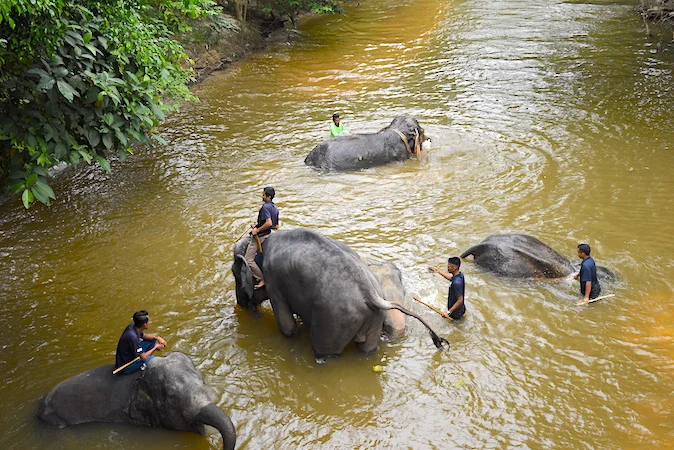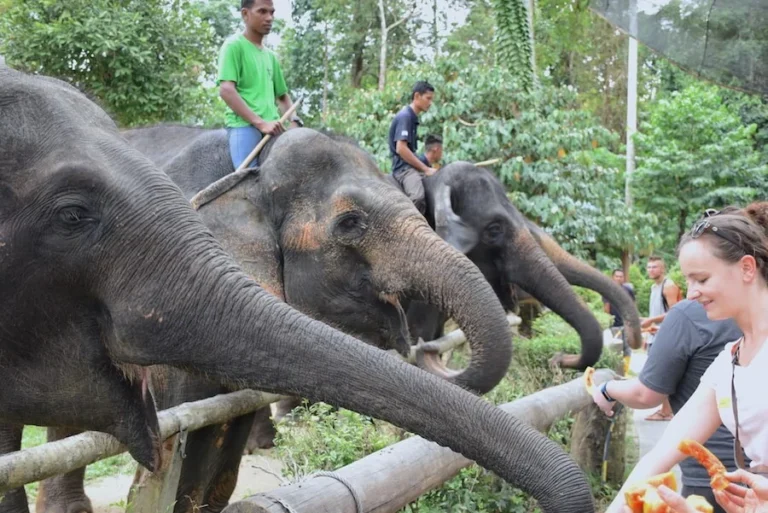Imagine wandering through the lush rainforests of Malaysia, where the vibrant sounds of nature surround you. Suddenly, you spot a majestic Asian elephant, its wise eyes and wrinkled skin captivating your heart. This enchanting encounter is not just a dream; it’s a reality in Malaysia, home to these magnificent creatures. However, the survival of elephants in this region hangs in the balance, making their conservation a pressing concern.
The Unique Subspecies of Malaysian Elephants
Malaysia boasts two distinct subspecies of Asian elephants:
- Mainland Asian Elephant (Elephas maximus indicus): Found in Peninsular Malaysia.
- Borneo Pygmy Elephant (Elephas maximus borneensis): A smaller subspecies residing in Borneo, recognized only since 2003.
Historically abundant, elephant populations have dwindled dramatically due to habitat loss. Current estimates suggest there are approximately:
- Peninsular Malaysia: 1,251–1,466 elephants.
- Borneo: 1,100–1,600 elephants.
The Borneo pygmy elephant is particularly unique, characterized by a straighter back and smaller ears compared to its mainland counterpart.
Human-Elephant Conflict: A Growing Dilemma
As human populations expand and development encroaches on natural habitats, elephants face increasing challenges:
- Habitat Loss: Deforestation for agriculture, especially oil palm plantations, fragments elephant ranges.
- Human Encounters: Increased contact leads to crop raiding and property damage.
Conservation Efforts: Protecting Malaysia’s Giants
The Department of Wildlife and National Parks (DWNP) leads conservation efforts through various initiatives:
- Translocation: Elephants from conflict zones are captured and relocated to safer habitats like Taman Negara National Park. The Kuala Gandah Elephant Conservation Centre plays a vital role in this process.
- Electric Fencing: To prevent elephants from entering agricultural areas, electric fences are installed. Although costly, they effectively reduce crop damage.
- Habitat Protection: The DWNP is actively working to protect existing elephant habitats and create wildlife corridors through initiatives like the Central Forest Spine (CFS), which connects fragmented forest areas.
The Vital Role of Kuala Gandah Elephant Conservation Centre in Elephant Conservation
Nestled in the lush landscapes of Pahang, Malaysia, the **Kuala Gandah Elephant Conservation Centre** serves as a beacon of hope for the endangered Asian elephant population. Established in 1989, this sanctuary is not just a refuge for elephants; it plays a crucial role in their conservation and rehabilitation.
A Sanctuary for Displaced Elephants
The primary mission of the Kuala Gandah Centre is to provide shelter and care for elephants that have been displaced due to habitat loss or human-elephant conflicts. Many elephants arrive at the center after being found wandering in agricultural areas or suffering from injuries. Here, they receive:
- Medical Care: Injured or sick elephants are treated to ensure their recovery.
- Rehabilitation: The center focuses on helping elephants regain their strength and comfort around humans before they are relocated.
Translocation Efforts
One of the standout features of the Kuala Gandah Centre is its **translocation program**. The facility has successfully relocated over 400 elephants back into protected habitats, such as Taman Negara National Park. This initiative is vital for maintaining wild elephant populations and reducing human-elephant conflicts by ensuring that these majestic creatures can thrive in their natural environments.
Educational Outreach and Public Awareness
Kuala Gandah is also dedicated to educating the public about the importance of elephant conservation. Visitors can engage in various activities that promote awareness, including:
- Interactive Tours: Guided tours allow visitors to observe elephants up close while learning about their behaviors and needs.
- Documentary Screenings: Before tours, guests watch informative videos detailing the center’s conservation efforts and the challenges facing elephants.
- Feeding and Bathing Experiences: Visitors can participate in feeding sessions and watch elephants being bathed, providing a hands-on understanding of these animals’ care.
Promoting Responsible Tourism
The centre emphasizes responsible tourism, encouraging visitors to appreciate wildlife without causing harm. Entrance fees contribute directly to the care of the elephants and support ongoing conservation programs. By visiting Kuala Gandah, tourists play an active role in protecting these endangered animals.
Kuala Gandah- a sanctuary with a purpose
The Kuala Gandah Elephant Conservation Centre stands as a vital institution in Malaysia’s efforts to conserve its elephant population. Through rehabilitation, translocation, and education, the center not only cares for individual elephants but also fosters a broader understanding of wildlife conservation among visitors. This sanctuary is a testament to Malaysia’s commitment to protecting its natural heritage and ensuring that future generations can experience the wonder of these magnificent creatures.
Borneo’s Pygmy Elephants: Unique Challenges
Borneo’s pygmy elephants face distinct threats from logging and oil palm expansion. Collaborative conservation efforts between Malaysia and Indonesia are essential for their survival, as these elephants often migrate across borders
Responsible Tourism: Ethical Encounters with Elephants
For those wishing to experience the wonder of Malaysian elephants, responsible tourism is key:
- Choose Ethical Operators: Select tour operators who prioritize conservation and animal welfare.
- Visit Ulu Muda Forest Reserve: This eco-friendly destination allows visitors to observe elephants in their natural habitat while supporting conservation efforts.
Revenue from tourism helps fund research and conservation initiatives, creating a sustainable model for protecting these gentle giants.
The Future of Elephant Conservation in Malaysia
The path forward for Malaysian elephants requires a comprehensive strategy:
- Strengthening Legal Protections: Enhance laws safeguarding elephant habitats.
- Community Engagement: Foster public awareness and empathy towards elephants to inspire active participation in conservation.
Collaboration among government agencies, NGOs, and local communities is crucial for effective conservation strategies. With dedication and innovative solutions, we can work towards a future where humans and elephants coexist harmoniously in Malaysia.
In this journey towards conservation, every effort counts. By embracing sustainable practices and supporting ethical tourism, we can help ensure that future generations will also have the opportunity to witness the beauty of Malaysian elephants.




